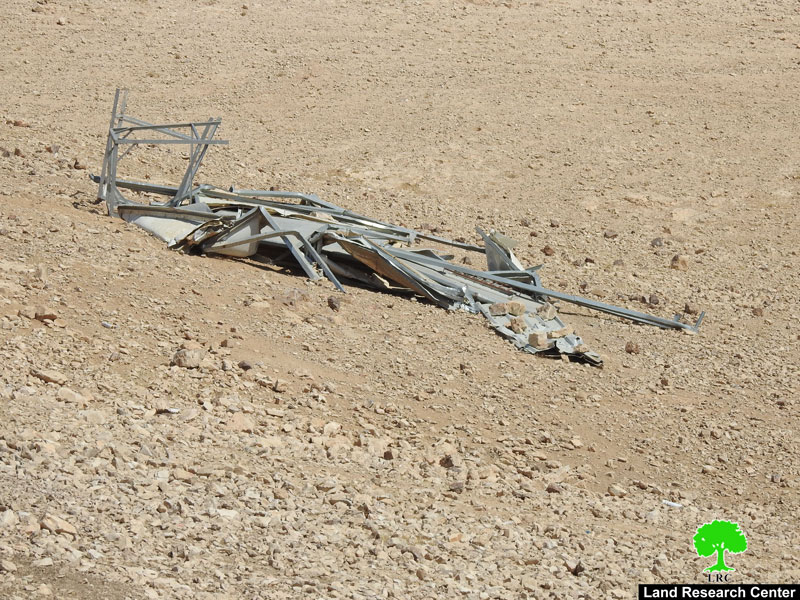- Violation: Demolition of a barn.
- Date: 13/06/2019.
- Location: Khashem ed-Daraj- Yatta village/ Hebron governorate.
- Perpetrator: The Israeli occupation civil administration.
- Victims: Family of Musa At-Tabneh.
Description:
Thursday, 13 June 2019, the Israeli occupation authorities demolished a barn that belongs to Musa At-Tabneh in Khashem ed-Daraj east Yatta , on the pretext of building without licenses.
At-Tabneh said that an army force supported by bulldozers reached the area and completely demolished the barn.
Reportedly, the targeted barn is built of steel sheets , and plastic sheds , and has an area of (50 m2), and is one of the barns where At-Tabneh keeps his herd.
At-Tabneh asserted that he received a stop work order earlier, and hired a lawyer to file an objection against the military order.
This is not the first time At-Tabneh finds himself a victim to the Israeli unfair measurements:
- In 29/04/2014: The occupation demolished the family’s residence ( a structure built of steels sheets and has an area of 70 m2)
- 10/09/2014: the occupation demolished two residents and a barn.
- 29/10/2014: the occupation demolished a barn (6 m2).
About Khashem ed-Daraj: [1]
It is situated to the southeast of Yatta town and is 20km away from it. The village has a total population of 800 people and is inhabited by several families namely( al-Tabanah, al-Hathalin, al-Faqir, and Hamadin). A roads network is there to link the village with other neighboring towns and cities. In addition to that, the town has many facilities namely (water and electricity networks, primary mixed-gender school, a clinic, a kindergarten, and three mosques).
Khashem ed-Daraj is surrounded by the natural reserve relative to Israel Nature Authority and the Dead (from the east), Um el-Khair and Arrab al-Najada (from the west), a military training camp for the occupation (from the north), and the villages of Khashem el-Karm and al-Dqiqa (from the south).
Land Research Center LRC sees that demolitions contradict with all the International conventions and Humanitarian laws including:
Article 17 of the (1948) Universal Declaration of Human Rights stating: “Everyone has the right to own property alone as well as in association with others. No one shall be arbitrarily deprived of his property.”
Section ‹G› of article 23 of the (1907) The Hague Conventions asserting: “In addition to the prohibitions provided by special Conventions, it is especially forbidden to destroy or seize the enemy’s property, unless such destruction or seizure be imperatively demanded by the necessities of war.”
Article 53 of the Geneva Fourth Convention (1948) declaring: “Any destruction by the Occupying Power of real or personal property belonging individually or collectively to private persons, or to the State, or to other public authorities, or to social or cooperative organizations, is prohibited, except where such destruction is rendered absolutely necessary by military operations.”
Section 1, Article 11 of the International Covenant on Economic, Social and Cultural Rights (1966): “The States Parties to the present Covenant recognize the right of everyone to an adequate standard of living for himself and his family, including adequate food, clothing and housing, and to the continuous improvement of living conditions. The States Parties will take appropriate steps to ensure the realization of this right, recognizing to this effect the essential importance of international co-operation based on free consent.”
[1] LRC
Prepared by
The Land Research Center
LRC













